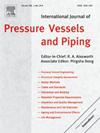A method for prediction of material creep curves and rupture life using limited creep data
IF 3
2区 工程技术
Q2 ENGINEERING, MECHANICAL
International Journal of Pressure Vessels and Piping
Pub Date : 2025-05-26
DOI:10.1016/j.ijpvp.2025.105565
引用次数: 0
Abstract
This study proposes a so-called ZC-parameter method for predicting creep curves and rupture life based on incomplete creep data for high temperature materials. Through predictions of creep curves and rupture life of a superalloy DZ125 under different temperature and stress conditions, the results show that this method can not only predict complete creep curves from limited creep data, but also show good agreement with experimental results, with all prediction results falling within the ±95 % confidence interval. Compared with traditional creep prediction methods, such as θ projection method, this method can consider and analyze the scatter of creep data to obtain reasonable prediction results. This method provides a new approach to perform reasonable prediction for creep performance.
利用有限蠕变数据预测材料蠕变曲线和断裂寿命的方法
本文提出了一种基于不完全蠕变数据预测高温材料蠕变曲线和断裂寿命的zc参数方法。通过对高温合金DZ125在不同温度和应力条件下的蠕变曲线和断裂寿命的预测,结果表明,该方法不仅可以根据有限的蠕变数据预测出完整的蠕变曲线,而且与实验结果吻合良好,预测结果均在±95%的置信区间内。与传统的蠕变预测方法(如θ投影法)相比,该方法可以考虑和分析蠕变数据的离散性,从而获得合理的预测结果。该方法为合理预测蠕变性能提供了新的途径。
本文章由计算机程序翻译,如有差异,请以英文原文为准。
求助全文
约1分钟内获得全文
求助全文
来源期刊
CiteScore
5.30
自引率
13.30%
发文量
208
审稿时长
17 months
期刊介绍:
Pressure vessel engineering technology is of importance in many branches of industry. This journal publishes the latest research results and related information on all its associated aspects, with particular emphasis on the structural integrity assessment, maintenance and life extension of pressurised process engineering plants.
The anticipated coverage of the International Journal of Pressure Vessels and Piping ranges from simple mass-produced pressure vessels to large custom-built vessels and tanks. Pressure vessels technology is a developing field, and contributions on the following topics will therefore be welcome:
• Pressure vessel engineering
• Structural integrity assessment
• Design methods
• Codes and standards
• Fabrication and welding
• Materials properties requirements
• Inspection and quality management
• Maintenance and life extension
• Ageing and environmental effects
• Life management
Of particular importance are papers covering aspects of significant practical application which could lead to major improvements in economy, reliability and useful life. While most accepted papers represent the results of original applied research, critical reviews of topical interest by world-leading experts will also appear from time to time.
International Journal of Pressure Vessels and Piping is indispensable reading for engineering professionals involved in the energy, petrochemicals, process plant, transport, aerospace and related industries; for manufacturers of pressure vessels and ancillary equipment; and for academics pursuing research in these areas.

 求助内容:
求助内容: 应助结果提醒方式:
应助结果提醒方式:


